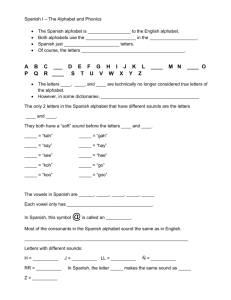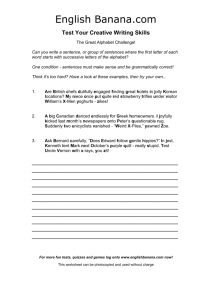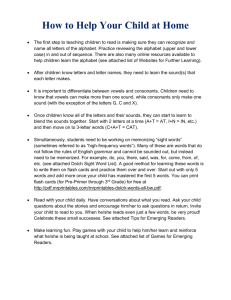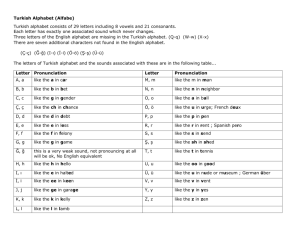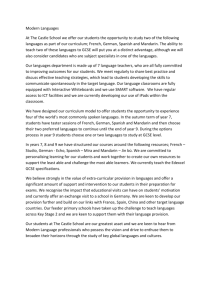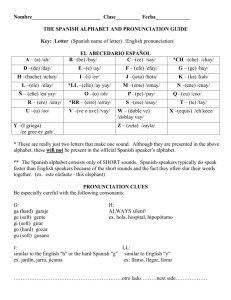Leisure activities
advertisement
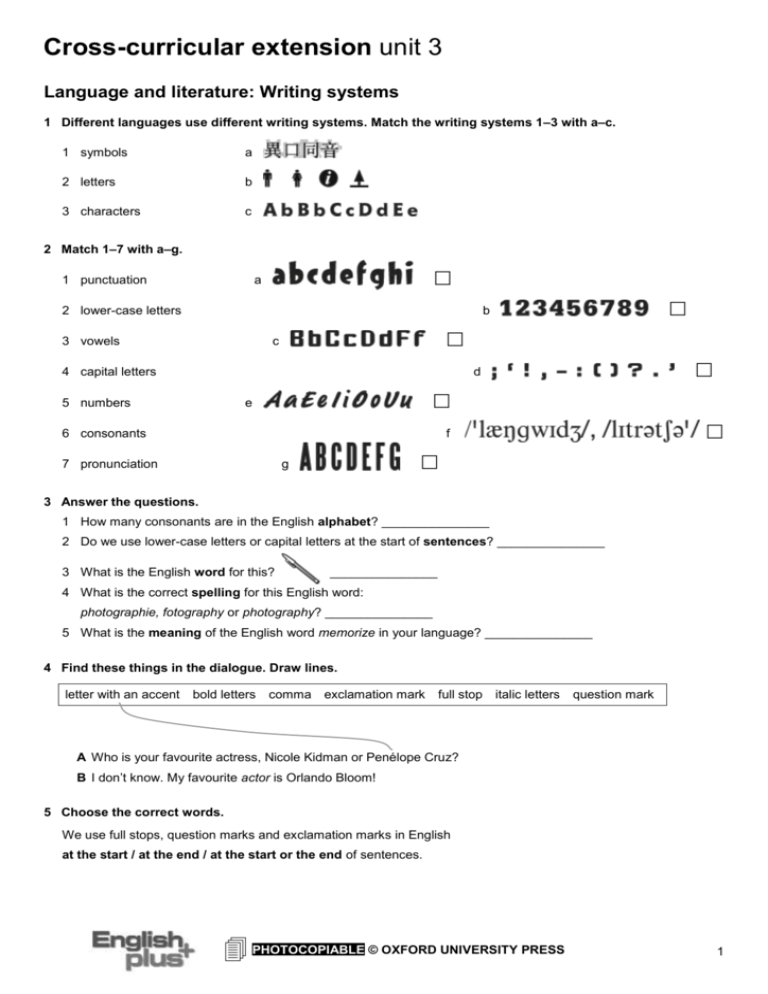
Cross-curricular extension unit 3 Language and literature: Writing systems 1 Different languages use different writing systems. Match the writing systems 1–3 with a–c. 1 symbols a 2 letters b 3 characters c 2 Match 1–7 with a–g. 1 punctuation a 2 lower-case letters b 3 vowels c 4 capital letters d 5 numbers e 6 consonants f 7 pronunciation g 3 Answer the questions. 1 How many consonants are in the English alphabet? _______________ 2 Do we use lower-case letters or capital letters at the start of sentences? _______________ 3 What is the English word for this? _______________ 4 What is the correct spelling for this English word: photographie, fotography or photography? _______________ 5 What is the meaning of the English word memorize in your language? _______________ 4 Find these things in the dialogue. Draw lines. letter with an accent bold letters comma exclamation mark full stop italic letters question mark A Who is your favourite actress, Nicole Kidman or Penélope Cruz? B I don’t know. My favourite actor is Orlando Bloom! 5 Choose the correct words. We use full stops, question marks and exclamation marks in English at the start / at the end / at the start or the end of sentences. PHOTOCOPIABLE © OXFORD UNIVERSITY PRESS 1 6 Look at the three words for tree below. What languages are these words in? Write your ideas, then check your answers in the text. árbol 1 __________ albero 2 __________ 3 __________ 7 Read the text again. Then answer the questions. 1 How many living languages are there in the world? _______________ 2 Which languages use characters? _______________ and _______________ 3 Which alphabet does Spanish use? How do you write that? There are currently 6,912 living languages in the world! There are different writing systems for different languages. Some writing systems use letters (like English, Spanish or Portuguese), but some writing systems use pictorial characters (like Mandarin or Japanese). There are 230 languages in Europe. Most of these languages use a writing system with a Latin alphabet. Some languages use the same alphabet, but the words have got different spellings and accents. For example, Italian and Spanish both use the same alphabet, but the words are different. The word for tree is albero in Italian and árbol in Spanish. In writing systems with an alphabet, the spelling of a word helps us to understand its meaning and pronunciation. In the Mandarin writing system, there isn’t an alphabet, but there are more than 50,000 characters. Every word has got a different character. These characters are pictures, and the basic characters look like the things they describe. For example, the character for tree also looks like a tree: . Some people think Mandarin is a very beautiful writing system, but many people think it’s difficult. One problem is that Mandarin characters do not tell us about the pronunciation of a word, only its meaning. _______________ 4 How many characters are there in Mandarin? _______________ 5 What does the word look a bit like? _______________ 6 Which language has got a very pretty writing system? _______________ 8 Why do some English and Spanish speakers think that Mandarin is difficult? _________________________________________ _________________________________________ 9 Use the internet or the library to find the answers to these questions. 1 What is the word ‘hello’ in Mandarin? _______________ 2 How many letters are there in the Arabic alphabet? _______________ 3 Which of these languages uses capital letters at the start of days and months: Portuguese, English or Italian? _______________ 10 Answer the questions about your language. Write complete sentences. 1 Does the writing system for your language use characters or letters? ______________ ________________________ ______________________________________ 2 How many vowels are there? How many consonants are there? ______________________________________ ______________________________________ 3 Is your language similar or different to English? Why? ______________________________________ ______________________________________ PHOTOCOPIABLE © OXFORD UNIVERSITY PRESS 2



